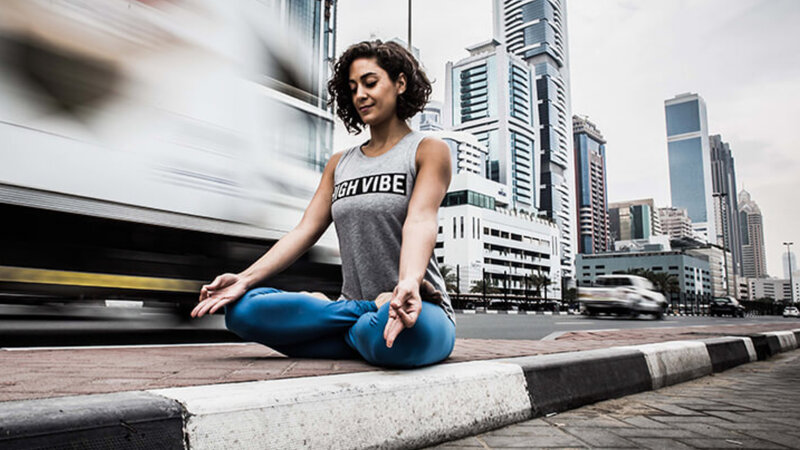What Happens When You Meditate Everyday?
Do you know what happens when you meditate every day when you feel that your mind does not stop and that your thoughts do not leave you alone? Would you like to learn to achieve peace of mind whenever you need it? We can achieve all this thanks to meditation.
In this article, we will talk about meditation and its relationship to yoga, how yoga can help you get started in meditation, its benefits, and some tips on how to get started.
Difference between yoga and meditation
Many wonder what differences exist between yoga and meditation. Yoga is a system that involves using the body to concentrate and breathe. While meditation is a procedure that has been in practice for centuries for the development of the mind. Yoga and Meditation are different but with common points. They can be united or separated.
Yoga is a good way to begin to relax the body, as a preliminary to meditation. It would be like entering meditation with prior preparation. With the work of yoga, we prepare the body and mind for concentration and meditation.
At first, it may be difficult for you but don’t worry, the great news is that you are like the rest of the mortals. The human mind is like that by nature. It goes from one thought to another without stopping.
Benefits of meditation
Do you know what happens when you meditate every day? There are many benefits that meditation brings, among them, a few are below:
- Gives peace and clarity of mind.
- Reduce stress.
- Improves sleep and concentration.
- Keeps the mind young.
- Improves the mood.
- Can decrease blood pressure
- Helps control pain
- Improves sleep
- Help to fight addictions
- Generate kindness
- Reduce age-related memory loss
- Improve concentration
- Enhances self-awareness
- Promotes emotional health
- Controls Anxiety
What is meditation?
Meditation is a specific method for developing and training the mind. It helps to cultivate lucidity, attention, inner contentment, compassion, calm, etc. so we must thank it. Even if you feel that your mind does not stop, the mind can be trained and develop skills to calm your thoughts.
Meditation techniques
There are many meditation techniques. The most traditional are Vipassana, Zazen, Shiné (Buddhist), Antar Mouna, Ajapa Japa (repetition of mantras), etc. These techniques include various exercises such as: observing the body, observing the breath, and thoughts, developing compassion, etc …
The techniques that are usually included in yoga are usually guides for the student to feel accompanied. These guides to stabilize the mind can be: observing external sounds, bodily sensations, breathing, making visualizations, chanting mantras, etc.
A meditation technique commonly performed by classical yoga is the Antar Mouna. Introduced by Master Swami Satyananda Saraswati. In Sanskrit Antar means to silence and inner Mouna (inner silence meditation). It is training to induce consciousness. It consists of different stages to train the mind. Starting from the senses to progressively reach the interior of our mind.
With this method, the student is taught to go deeper inside. It consists of different phases that are included little by little as the practice progresses. This method is usually included in many Yoga workshops which can be found around you.
How to start meditating?
There is a widespread idea that those who meditate manage to eliminate all their thoughts and even levitate. With a lot of practice, meditative states can be reached in which one feels the energy very present and the mind light and free of thoughts. You must bear in mind that learning meditation can last a lifetime.
3 Aspects to consider when meditating
1. The Posture
Body posture in meditation is of great importance. The pelvis and sitting bones should have good support. The spine must be erect. Relaxed shoulders, arms, and face. There are people who feel pain in the meditation posture. Therefore, there is the option of meditating and sitting in a chair.
In this position, you should keep your feet flat on the floor, your legs at a 90-degree angle, and your back upright (without much support on the backrest to avoid drowsiness). In meditation, the immobility of the body is very important. Body movement makes the mind scattered. If the spine remains upright and the body immobile, we will get the energy to flow to the brain and keep us awake.
2. The material
Unless you have exceptional flexibility, it is recommended to meditate on a cushion. The reason is to make it easier for the spine to be upright and for the knees to be below the groin. There is also the possibility of using a block or brick and placing a blanket on it.
For certain people, this material is usually more comfortable. On the other hand, mala (bead necklace), mantras, and breathing exercises can be used to help relax the body and mind and prepare for meditation.
3. The habit
Continuity in time adds depth to meditative practice. Repetition builds the habit. As you progress through your meditation routine, it will become easier for you to calm your mind.
How to meditate at home?
If you dare to meditate in the privacy of your home, here are these two suggestions:
- Try to meditate at the same time (or at least in the same time slot) and in the same place. Create a meditation place at home that inspires you. Decorated with everything you like.
- Meditate in a quiet place, with a dim light and a comfortable temperature, not too hot that invites drowsiness, nor too cool that makes us shrink the body.
Exercises to meditate at home
- Do a body check: go through and feel each area of your body with the sensations that come, positive or negative.
- Observation of respiration: you can bring your attention to the frequency of respiration, to the respiration in the abdomen, to the temperature of the air in the nostrils when inhaling and exhaling, to the silences or small retentions between inspiration and expiration, etc.
- Observation of thoughts: we let thoughts flow without being attached to them. They come and they go.
- Visualizations to focus: on shapes, colors, chakras, etc.



























Nice info! keep sharing new ideas